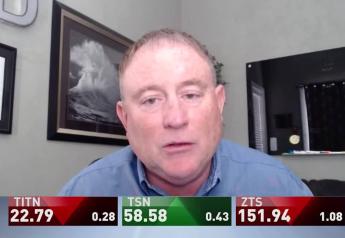Climbing Corn Prices Create More Headwinds for Ethanol’s Recovery in 2021
USFR-Ethanol Recovery 2021 FJR
As commodity prices continue to catch fire in 2021, USDA’s reports this week added fuel.
“This rally will probably go down as the longest, biggest rally we’ve had for this time period,” says Bob Utterback of Utterback Marketing.
Corn prices briefly topped the $5 mark last week, but with a limit up move after Tuesday’s report, corn farmers are now staring at $5 across the board. While it’s a welcome sign for farmers, it’s not good news for ethanol producers.
“For our industry, we think the road to recovery from COVID is a long road and it's full of potholes,” says Geoff Cooper, president and CEO of Renewable Fuels Association (RFA). “And we're actually worried about hitting some of those potholes in the weeks ahead.”
Waning Margins
As the ethanol industry continues to recover from the impacts COVID-19 is having on gasoline demand, climbing corn prices aren’t helping margins for ethanol producers.
“We've seen margins in the last few weeks go negative in some geographies, and that's just not sustainable,” Cooper adds. “If that lasts for several weeks, we would expect to see some additional plants go idle or certainly reduce their output rates.”
Just last week, the oldest ethanol plant in the country decided to call it quits. Ingredion in Cedar Rapids cited declining margins and weak demand as the reasons it would stop producing ethanol.
“Out of the 200 ethanol plants nationwide, we think there are about two dozen that are completely idle today,” Cooper says. “That many more may have significantly reduced their production rates.”
Growth Energy says other ethanol producers are facing a similar dilemma, as higher corn prices continue to eat into margins.
“I have plants that never opened back up since they shut down because of COVID, and I have plants that are going to have to really curtail their production and may be closed down for a period because of the soft demand right now,” says Emily Skor, CEO of Growth Energy.
Road to Recovery
RFA reports fuel consumption today is 10% to 15% below a year ago, which is a major hurdle for U.S. ethanol producers.
“We don't really expect ethanol demand to approach pre-pandemic levels until the vaccine is widespread and the existing lockdowns are lifted,” Cooper says.
As the race to get America vaccinated is underway, Pete Meyer of S&P Global Platts says the road to recovery for ethanol could be another year out.
“My crystal ball doesn't just doesn't really see as getting back to pre-pandemic levels, probably for another year or so,” he says. “I would say Q4, and then going into Q1 of 2022, once everybody feels comfortable, and once we also have a feel comfortable with the fact that enough, enough people have been vaccinated against COVID.”
And as cases rise and more people stay at home, ethanol producers are facing a situation similar to what they saw last spring.
“Look at these ending stocks numbers,” says Meyer pointing to an Energy Information Administration chart. “This is this a problem. This is this is a seven month high here just this week at 22.9 5 million barrels. And you look at this growth over the last four weeks. This is this is very much concerned for us. “
Growing Dilemma
Growing stocks are a concern for the industry, and an even bigger concern for ethanol producers watching stocks pile up.
“I've talked to several members just in the past 24 hours who say that if they haven't already started to slow down, they will in the next few days or weeks, because we've just got an oversupply of ethanol right now,” Skor says.
National Corn Growers Association (NCGA) says 2020 was a double whammy for demand loss.
“Nearly 5 billion gallons of ethanol demand was destroyed because of the small refinery exemptions, another 2 billion gallons, that of demand that we've lost since March, because of the pandemic,” says Jon Doggett, NCGA CEO.
As the corn market shrugs off the demand destruction taking place, Growth Energy also has hope a recovery is possible for ethanol this year.
“The suppressed demand right now is primarily because of the pandemic,” Skor says. “So, we need people to start moving again, we need the economy to open back up. We saw some of that in the summer. We need that to recover. I think our optimism comes from hope the vaccine is going to make its way quickly through the United States and elsewhere as well.”
RFA says with more people working from home indefinitely and changing travel habits, there’s a strong possibility some of the demand will never come back. But Cooper says there are also offsetting factors that could be good for ethanol demand.
“We know mass transit in the larger urban areas is down, people are not taking the subways and metros, they're driving their cars into work,” says Cooper. “We actually see some major cities, places like New York, Los Angeles, Chicago, where there's kind of an exodus of the population from those very densely populated city centers and kind of into the suburbs. And that all results in in greater vehicle traffic.”
Changing Demand Worldwide
The changing habits aren’t just taking place in the U.S. Meyer says COVID-19 is changing the way goods are consumed around the globe.
“Ukraine has had a bad corn crop, and they typically export a lot of corn to the EU. There just isn't demand there for ethanol because they're under an even tighter lockdown structure than we are here in the U.S.,” says Meyer.
Building Exports
As ethanol’s road to recovery seems bumpy, RFA says there is one major factor that could give ethanol a needed boost.
“We think the biggest shot in the arm the ethanol market could get is reopening of the export market,” Cooper says.
At the top of the list for export market growth opportunities is one major possible buyer: China.
“China was once our third leading export market. And we're sending very little ethanol to China today because of a tariff that remains in place in that market,” Cooper says.
Beyond China, Brazil is another potentially major market.
“Our relationship with Brazil and ethanol goes back 30, 40 years,” Doggett says. “It's always been weird. And there's always been disruptions. We had tariffs on Brazilian ethanol, and they retaliated, and it's been back and forth. I think that we can resolve this this issue with Brazil, but it's a tough one.”
Just last month, Brazil announced all U.S. ethanol imports would face a 20% tariff. It’s a move Cooper says severely constrains the U.S.’ ability to export there.
“We're looking for a new administration to really help us reestablish the free and fair trade relationships that we had with these markets, and really jumpstart our export program, as we head into 2021,” Cooper says.
More than just China and Brazil, Doggett says exports to other countries could also fill the gaps.
“If we could get the Mexicans to accept ethanol in the three largest cities in Mexico, that's a huge market. India has a lot of potential, Vietnam has a lot of potential,” says Doggett.








